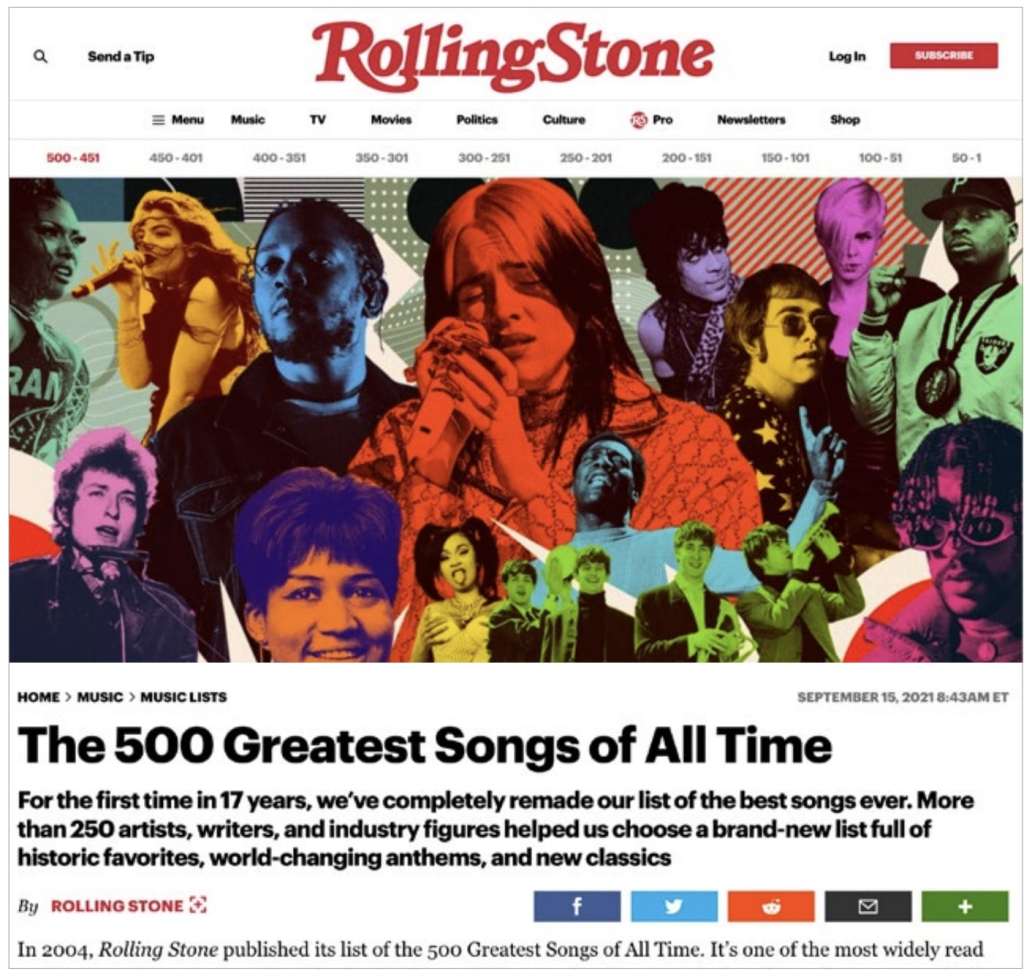Digital Publishing Rocks: Behind the Scenes of Product Innovation at Rolling Stone
How open source software and partnerships save money and evolve digital properties

“Product innovation” and “rock ‘n’ roll” aren’t terms you usually hear together, but they’re in perfect harmony when it comes to iconic brand Rolling Stone and the work the media legend undertakes to stay relevant decade after decade.
They’ve learned the joys of leveraging technology partnerships and an agile content platform like WordPress VIP to drive the product innovation necessary to stay at the top—a prime example of a brand constantly innovating and pushing beyond “what everyone knows us for.”
Any brand can take inspiration from their example of designing an agile technology stack, capable of rolling with market changes while simultaneously creating great customer digital experiences that drive revenue.
This ebook covers:
- How to adopt an integrated approach to design and development partnerships
- Guidelines for reducing the total cost of ownership of your digital properties
- The benefits of an open source content management system
- What success looks like for a content-driven product
You’ll also find practical tips to improve your team’s go-to-market capabilities.
“We would not be as successful as we are if we didn’t have this open-source ethos and mentality—and everyone in the team open to that as well.”
— Nici Catton, VP of Product Delivery, PMC (parent company of Rolling Stone)

Meet our experts
We gathered a panel of experts on what it takes to stay on top of product innovation at a brand like Rolling Stone.

Nici Catton
VP of Product Delivery
Penske Media Corporation (PMC)

Leo Postovoit
Head of Product Strategy and Partnerships
WordPress VIP partner agency XWP

Liz McDonald
Lead Technical Account Manager
WordPress VIP
Adopt an integrated approach to design and development partnerships
If your team’s approach to projects isn’t as streamlined and efficient as you’d like, pause and take a step back. Ask yourself these questions:
- What can your team realistically handle? Do you have outside,
on-call resources that can be contracted to assist? - Could formal technology partnerships help you get you where you ultimately want to go?
- What can you build better together with the right partner, rather than on your own?
- How can that work benefit both of your teams?
Consider going out of house for a mutually beneficial partnership
For projects that don’t need to be done in-house, consider partnerships. The greatest partnerships are all about give and take, pushing back where necessary so that you can push forward together.
Leo Postovoit, Head of Product Strategy and Partnerships at XWP (a WordPress VIP partner agency) agrees.
“Find a partner who’s going to help you on that journey and not just say, ‘Yes, yes, yes.’ Sometimes you say ‘no,’ or ‘maybe,’ or ‘How do we do this in the best way? How do we deliver this small first and then iterate toward a bigger piece?’ That’s what we try to do—agile delivery with innovation in mind.”
— Leo Postovoit, Head of Product Strategy and Partnerships at XWP
Call in the right people at the right time
Knowing when to bring the right stakeholders into the conversation is crucial for an integrated approach that saves time in the long run.
Bringing engineers in too early risks breaking their flow on another brand-critical project or area of focus. Bringing them in too late on an unfeasible technical solution that simply isn’t viable is a colossal waste of resources and expertise.
It’s a delicate balance to stay agile as a brand and bring in the right partners to help you stay that way.
“How do we integrate in a way that allows our users to have a seamless experience without knowing that they’re jumping from system to system?”
— Nici Catton, VP of Product Delivery, PMC
Know when to pivot, all along the watchtower
A good partner will help you course correct when a project isn’t performing as expected.
“Having a close relationship with PMC means that we know where things stand in their roadmap and in their sense of priority,” says Liz. “We’re just trying to be really deeply embedded in everything in terms of understanding the roadmap and their individual project metrics as well.”
A partner equally invested in your workflows will make those pivots on your product journey as nimbly as possible.
Introduce new technologies thoughtfully
“With most new technologies, there’s nothing out there that does it all,” says Nici. “You consider that, ‘Okay, this does this really well, and this does that really well. How do we integrate in a way that allows our users to have a seamless experience without knowing that they’re jumping from system to system?’”
New technologies are exciting. But they bring the challenge and pain of change that communication between partners must minimize. “One of the most important things for us as a partnership is honest and frank communication,” says Nici. “There is no point in either side being blind to what the other side is experiencing or where they’re coming from.”
When partnerships are well-matched, the best work happens. Setting teams up with the right tools to bring their ideas to life and execute on project expectations is the next big step.
Reduce the total cost of ownership of your digital properties
With so many brands under its roof, PMC can’t afford to reinvent the wheel every time on every project. “We would never get anything of value done,” says Nici. Yet, having an experimentation mindset is still key.
There’s always a risk when an iconic brand launches something new to a paying audience. “But things fail—things need to fail— so that you can make them better,” Nici says.

‘Scuse me while I copy and paste to save work
As you build those experimental elements, think about what you can make repeatable to take load off of the overall system.
“There’s probably a lot that can be overlapping and shared. Whether it’s a multi-site universe that you’re building out or individual plugins and themes being used across the board, trying to create something that is repeatable is going to be really useful,” Leo says.
Don’t think you have to roll out an experiment everywhere at the same time either. Consider an 80/20 approach, where 80% of your sites are running on a core, repeatable design while 20% is dedicated to a more localized, experimental approach. What can you play with that makes sense in this space that wouldn’t necessarily make sense anywhere else?
Stay agile, ask the right questions, don’t get hung up too much about it
Staying agile is powerful here, too. It’s a way to be proactive and reactive at the same time; trying to plan for things you think will move the business forward while also being able to react to what’s going on in the world. You need the right structure in place for your team to be able to do both.
A big part of that approach is making sure you’re asking the right questions. Why are we doing this? Why are we doing this right now?
Says Leo: “A big part of agility as you embody it in your team is asking, ‘What do we really need?’ If something comes up, ‘Should I change it? Am I listening to all the stakeholders internally and externally?’”
This weaves together the right partners and the right framework for tackling a project as efficiently as possible.
But don’t get hung up on the technicalities of using agile as a methodology. It’s okay to simplify things for your team. “If you think about it, ‘backlog grooming’ is basically throwing your ideas on a sheet,” says Leo. “‘Sprint planning’ is basically deciding what you’re doing over the next period of time. A ‘demo and a retro’ is showing off what you just did.” Just be “agile enough.”
There’s another fantastic tool that can help keep your brand from reinventing the wheel, but that also leaves space for experimentation and other key guidelines we’ve touched on.
Go open source.
“A big part of agility as you embody it in your team is asking, ‘What do we really need?’”
— Leo Postovoit, Head of Product Strategy and Partnerships, XWP
Leverage an open source content management system
Open source software’s code is available to the public and free to use, meaning anyone can access, modify and share the source code. And any improvements or new features made to this code can be shared back with the community. This means solving common problems faster.
And for Liz, it means her support team gets incredibly excited for tickets to come in that say, “Hey, we’re thinking about this long-term project six to 12 months out, can you tell us how other customers are tackling this business problem?” Sharing knowledge among open source users can help everyone think about where their roadmaps overlap and how everyone can make the best use of their time.
“One of the big things we talk about is doing things ‘the WordPress way,’” says Leo. “A part of the open source core ethos is making new features or extensions work not only at an enterprise or individual scale, but across the 200 million websites that run WordPress.”
Make sense of success metrics
What does success look like for you?
It’s easy to get caught up in traditional success metrics—traffic, engagement, revenue. Yes, they’re foundational, but not the only things that matter to a brand.
For Rolling Stone, editorial success matters, too. Their editorial teams need to feel supported with exceptional publishing tools that help them continue the great work that has set them apart for decades when it comes to journalism, photography, and more.
It’s a constant balancing act between business success metrics and how teams know they’re reaching and engaging audiences on content distribution channels.
“When we talk about success metrics… what I also like to think about a little is the flip side—our road mapping, resourcing, and business planning.”
— Nici Catton, VP of Product Delivery, PMC
Are you experienced enough to question new technology and new processes?
For example:
- Are requests for improved products to reach your audience getting filled and, if so, how quickly?
- Are new tools adding value beyond basic requests?
- Are teams able to pivot fast when something isn’t performing as expected?
Every brand has to examine the metrics that make sense for them beyond the basic goals they’re expected to meet—that’s the kind of discipline that sets you apart from competitors.
“When we talk about success metrics, it’s easy to just ask, ‘Are we making money? Is our traffic up? Are our page views up?’” says Nici. “What I also like to think about a little is the flip side—our road mapping, resourcing, and business planning.”
From XWP’s POV, another key metric is site performance.
“We want to make sure sites are fast, reliable, and viewable in every part of the world,” says Leo, “and make sense on mobile devices. Another big thing for people looking to innovate their product is asking if it’s easy for the editorial teams and audiences alike to use? Is it actually viewable?”

And, in the end, be like a Rolling Stone
For content-driven product innovation to be successful, put down a good foundation with a good partnership. Challenging you to do better work, good partners help you experiment, innovate, iterate, and pivot (think agile) without having to reinvent the wheel—and help build on your successes while learning from your failures.
Reduce total cost of ownership by building repeatable systems that save time and toil, while saving all-important experimentation for key initiatives. Remember to go beyond foundational metrics for a broader perspective. Finally, consider leveraging open source software, which allows rapid knowledgesharing and collaboration to keep up with industry trends.
That’s success for any brand. And, we think, pretty rock ‘n’ roll.


